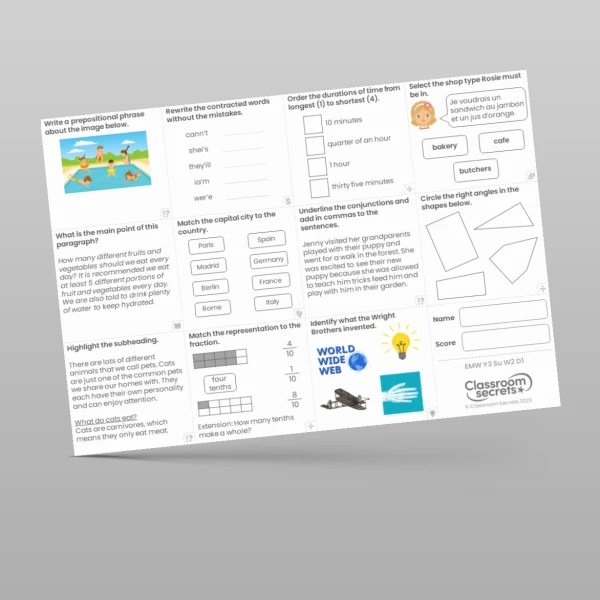

Assess what your children know and understand about using correct punctuation when you download this KS2 Correct Punctuation activity.
With four differentiated worksheets to choose from, children are presented with a range of multiple choice questions in which they will need to use and apply what they know about punctuation in order to identify the correct sentence.
Suitable for use by individuals, this resource could be used as a pre-assessment activity to inform future planning or used as part of paired or group work. Answer sheets are provided to help promote self or peer marking in the classroom.
Differentiation:
Beginner Tick the sentence which uses capital letters and full stops correctly. Four options to choose from. Aimed at Year 1 Secure/Year 2 Emerging.
Easy Tick the sentence which uses capital letters, full stops, exclamation marks and question marks correctly. Four options to choose from. Aimed at Year 1 Mastery/Year 2 Secure.
Tricky Tick the sentence which uses capital letters, full stops, exclamation marks, question marks and inverted commas for speech correctly. Four options to choose from. Aimed at Year 3 Secure/Year 4 Developing.
Expert Tick the sentence which uses capital letters, full stops, exclamation marks, question marks, inverted commas for speech correctly and dashes for parenthesis. Four options to choose from. Aimed at Year 5 Secure.
Curriculum Objectives
- Beginning to punctuate sentences using a capital letter / Using a capital letter for names of people, places, the days of the week, and the personal pronoun ‘I’ / Introduction to capital letters to demarcate sentences / Terminology for pupils: letter / Terminology for pupils: capital letter
- Beginning to punctuate sentences using a full stop / Introduction to full stops to demarcate sentences / Terminology for pupils: full stop
- Beginning to punctuate sentences using a question mark / Introduction to question marks to demarcate sentences / Terminology for pupils: question mark
- Beginning to punctuate sentences using an exclamation mark / Introduction to exclamation marks to demarcate sentences / Terminology for pupils: exclamation mark
- Learning how to use both familiar and new punctuation correctly including: full stops / Use of full stops to demarcate sentences
- Learning how to use both familiar and new punctuation correctly including: capital letters / Use of capital letters to demarcate sentences
- Learning how to use both familiar and new punctuation correctly including: exclamation marks / Use of exclamation marks to demarcate sentences
- Learning how to use both familiar and new punctuation correctly including: question marks / Use of question marks to demarcate sentences
- Indicate grammatical and other features by: Using and punctuating direct speech / Use of inverted commas and other punctuation to indicate direct speech [for example, a comma after the reporting clause; end punctuation within inverted commas: The conductor shouted, "Sit down!"]
- Indicate grammatical and other features by: Using brackets, dashes or commas to indicate parenthesis / Brackets, dashes or commas to indicate parenthesis / Terminology for pupils: parenthesis / Terminology for pupils: bracket / Terminology for pupils: dash
Tags
Punctuation
Test Practice
1G5.1
1G5.2
1G5.3
1G5.4
2G5.2
2G5.1
2G5.4
2G5.3
4G5.7
5G5.9
Year 3 Test Practice
Year 4 Test Practice
Year 5 Test Practice
Year 6 Test Practice
Year 6 SATs Preparation











